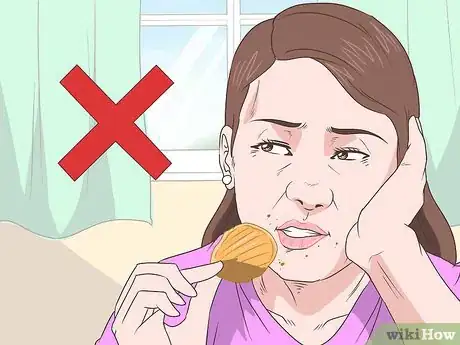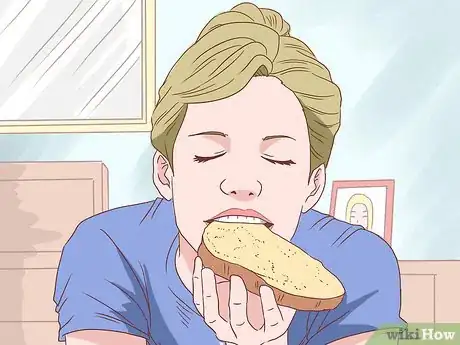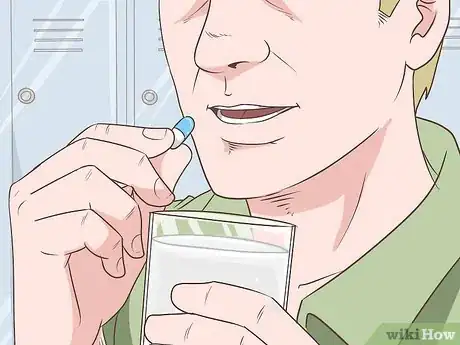This article was medically reviewed by Luba Lee, FNP-BC, MS and by wikiHow staff writer, Aly Rusciano. Luba Lee, FNP-BC is a Board-Certified Family Nurse Practitioner (FNP) and educator in Tennessee with over a decade of clinical experience. Luba has certifications in Pediatric Advanced Life Support (PALS), Emergency Medicine, Advanced Cardiac Life Support (ACLS), Team Building, and Critical Care Nursing. She received her Master of Science in Nursing (MSN) from the University of Tennessee in 2006.
There are 17 references cited in this article, which can be found at the bottom of the page.
This article has been viewed 225,516 times.
Hunching over and getting sick is definitely not fun. If you're still feeling shaky and nauseous after throwing up, the good news is that there are simple things you can do to feel better and recover faster. To help you out, we've rounded up expert-backed strategies for recovering from vomiting, including immediate tips for right now plus things you can do over the next 24 hours to get back to feeling like yourself again.
Things You Should Know
- Drink small sips of water and suck on ice chips after you’ve thrown up to stay hydrated.
- Step outside and get some fresh air to relieve nausea.
- Rest in an upright position after throwing up instead of laying down to help your stomach settle.
- Follow the BRAT (bananas, rice, applesauce, and toast) diet after you’ve stopped vomiting to slowly start eating again.
Steps
Settling Your Stomach
-
1Rest in an upright seated position with your head elevated. Moving around after you vomit can make you feel more nauseous, so do your best to stay still. Prop yourself up and rest in a seated position with your head elevated about 12 inches (30 cm) above your feet to help your body recover.[1]
- Avoid lying down in a flat position to rest, even if you vomit in the middle of the night; this may inadvertently cause you to start throwing up again.[2]
- Stay in this resting position for at least an hour or until your stomach no longer feels nauseous.
- If you vomit at night, try sleeping upright in a recliner or watching TV in a seated position until you feel well enough to go back to bed.
-
2Place a cool compress over the back of your neck. Hold a clean washcloth under cool, running water until it’s soaked. Then, wring the washcloth out and fold it in half. Lay the cloth across the back of your neck and keep it there for 5 to 10 minutes to soothe your nervous system and lower your body temperature.[3]Advertisement
-
3Avoid strong or unpleasant smells until you’re no longer nauseous. Tobacco smoke, strong perfumes, or spicy-smelling foods can cause vomiting if you’re already nauseous. Limit your exposure to these kinds of scents until you’ve gone at least 24 hours without vomiting.[4]
- Hot foods tend to have stronger scents than cold foods, so avoid heating up leftovers or cooking while you’re nauseous.
-
4Refrain from taking oral medications that may irritate your stomach. These include aspirin, non-steroidal anti-inflammatory drugs (NSAIDs) like ibuprofen or naproxen, and blood pressure medications. Consult with your doctor before stopping any oral medicines you were taking for a different condition before you started vomiting.[5]
- Some antibiotics have also been known to cause nausea; however, you should never stop taking antibiotics before talking with your doctor first.
-
5Go outside for fresh air if you still feel nauseous. Getting fresh air by taking a stroll can be a great way to manage nausea and vomiting. The crisp and open environment helps calm your senses. Just make sure not to overexert yourself on your walk, as too much physical activity could make your symptoms worse.[6]
- If walking outside isn’t feasible, try sitting by an open window to breathe fresh air.
-
6Diffuse essential oils to relieve your nausea. Inhaling certain scents through aromatherapy may help ease your nausea and calm your nerves after throwing up. Place a few drops of essential oils in a diffuser to fill the room with a nausea-fighting aroma.[7] Try using one or more of these oils:
-
7Try deep breathing exercises to quell nausea. Believe it or not, deep breathing has been scientifically proven to decrease feelings of nausea and symptoms of an upset stomach. Sit in a comfortable position, close your eyes, and inhale deeply through your nose for 5 seconds. Then, slowly exhale through your nose for 7 seconds. Repeat this process until you start feeling better.[10]
- Fill your lungs completely when you inhale to get the best results.
Eating & Drinking After Vomiting
-
1Refrain from eating or drinking for 15 minutes to let your stomach rest. Your stomach muscles will feel sore after you throw up, especially if you vomited a lot. Letting your stomach rest and calm down will reduce the risk of you vomiting again when you do try to eat.[11]
- It’s okay to rinse your mouth with a little bit of water to get rid of the taste of vomit after you throw up. Just try to avoid swallowing any of it for the first 15 minutes.
-
2Drink small sips of water or suck on ice chips to prevent dehydration. After 15 minutes have passed and you haven’t vomited again, start taking sips of water every 5 to 10 minutes to get fluids back into your system. Vomiting causes you to lose a lot of water, so it’s important to rehydrate your body as soon as you’re able to.[12]
- If you start vomiting again after drinking water, stop drinking and wait another 15 to 20 minutes before trying again.
- Try sipping on weak teas, sports drinks, or clear soft drinks without carbonation at this stage to put a different flavor in your mouth.
-
3Chew on a piece of fresh ginger or sip a cup of ginger tea. Ginger has antiemetic properties, which means that it can help to stop nausea and vomiting. If you have some fresh ginger around, cut off a 0.5 in (1.3 cm) piece and chew on it or use it to make ginger tea.[13]
- To chew on the ginger, cut off the skin with a knife and place the whole piece in your mouth.
- To brew tea, steep cut ginger in boiling water for 10 minutes.
-
4Try eating bland, soft, starchy foods 8 hours after you’ve stopped vomiting. Wait until you can keep liquids down for 8 hours without vomiting before you try eating. When you’re ready to eat, start with the BRAT diet—eating foods that are easy to digest, like bananas, rice, applesauce, and toast.[14]
- The BRAT (Bananas, Rice, Applesauce, and Toast) Diet is recommended for people suffering from an upset stomach.
-
5Eat small meals every 2 to 3 hours to slowly return to a normal diet. Focusing on smaller meals puts less strain on your stomach than eating a big meal every 6 to 8 hours. Try eating small meals composed of mashed potatoes, rice, cream soup, pretzels, and low-fat pudding.[15]
-
6Avoid caffeine, tobacco, and alcohol until your stomach feels better. Caffeine, alcoholic drinks, and tobacco products can irritate your stomach and potentially cause you to start vomiting again. To be safe, avoid consuming these products for at least 24 to 48 hours after you’ve stopped vomiting.[18]
- If you’re lactose intolerant or sensitive to dairy, also refrain from eating dairy products.
Recovering Physically from Nausea
-
1Limit physical activity for at least 1 to 2 days. After vomiting, your body will need plenty of rest. Too much physical activity after getting sick can aggravate your symptoms and make it harder to recover. So, avoid overexerting yourself until the nausea is completely gone.
- If you have friends or family who can help care for you while you’re recovering, ask if they’d be willing to stay with you until your nausea is gone.
-
2Use medication to control frequent nausea and vomiting. If you’ve done all you can through self-care to control your nausea and still have frequent bouts of vomiting, ask your doctor for help. They’ll be able to prescribe an anti-nausea medication to help manage your symptoms.[19]
- Commonly prescribed anti-nausea medications include Phenergan and Zofran.
- Note that some over-the-counter medications used to treat upset stomachs, such as Pepto-Bismol and Kaopectate, probably won’t stop your vomiting if you have a stomach virus.
-
3Go to the doctor if your vomiting doesn’t go away or gets worse. Although vomiting and nausea usually go away within 24 hours, they can sometimes be signs of more serious illnesses. Seek medical attention if your vomiting lasts for more than 24 hours, there’s blood in your vomit, or you start to experience severe abdominal pain.[20]
- Contact a doctor if you have nausea without vomiting that persists for more than 48 hours.
Expert Q&A
Did you know you can get premium answers for this article?
Unlock premium answers by supporting wikiHow
-
QuestionI only threw up a teeny bit, but it was green bile. It has been an hour or two. Do I seriously need to wait 7 or 6 more hours until I eat toast, just with jam and no butter?
 Luba Lee, FNP-BC, MSLuba Lee, FNP-BC is a Board-Certified Family Nurse Practitioner (FNP) and educator in Tennessee with over a decade of clinical experience. Luba has certifications in Pediatric Advanced Life Support (PALS), Emergency Medicine, Advanced Cardiac Life Support (ACLS), Team Building, and Critical Care Nursing. She received her Master of Science in Nursing (MSN) from the University of Tennessee in 2006.
Luba Lee, FNP-BC, MSLuba Lee, FNP-BC is a Board-Certified Family Nurse Practitioner (FNP) and educator in Tennessee with over a decade of clinical experience. Luba has certifications in Pediatric Advanced Life Support (PALS), Emergency Medicine, Advanced Cardiac Life Support (ACLS), Team Building, and Critical Care Nursing. She received her Master of Science in Nursing (MSN) from the University of Tennessee in 2006.
Board-Certified Family Nurse Practitioner If you have just vomited, it is best to take a break from eating. It is important to keep yourself hydrated by drinking small amounts of clear fluids such as water, or tea or a sport drink with electrolytes and let your stomach rest without eating food. Avoid caffeine and fizzy drinks with sugar. Drink cool or cold liquids to help with nausea. As time goes on and you are able to keep liquids down without having an upset stomach, you may start eating soft bland foods such as toast, rice, bananas, or applesauce. Eat slowly and avoid greasy and acidic foods. Follow-up with your medical provider if your symptoms are getting worse or not resolving.
If you have just vomited, it is best to take a break from eating. It is important to keep yourself hydrated by drinking small amounts of clear fluids such as water, or tea or a sport drink with electrolytes and let your stomach rest without eating food. Avoid caffeine and fizzy drinks with sugar. Drink cool or cold liquids to help with nausea. As time goes on and you are able to keep liquids down without having an upset stomach, you may start eating soft bland foods such as toast, rice, bananas, or applesauce. Eat slowly and avoid greasy and acidic foods. Follow-up with your medical provider if your symptoms are getting worse or not resolving.
Tips
- If the taste of vomit lingers in your mouth, try sucking on hard candy. It may not cure your upset stomach, but it can get rid of the sour, unpleasant taste.
Warnings
- Go to the doctor immediately if there’s blood in your vomit or vomiting is accompanied by a severe headache or abdominal pain, lethargy, confusion, a fever over 101 °F (38 °C), or rapid breathing. These may be signs of a more serious medical condition.
- If vomiting lasts more than a few hours in a child under the age of 6 or more than 3 days in a child over the age of 6, take the child to see a doctor.[21]
References
- ↑ https://my.clevelandclinic.org/health/symptoms/8106-nausea--vomiting/care-and-treatment
- ↑ https://www.mayoclinic.org/tests-procedures/chemotherapy/in-depth/cancer/art-20047517
- ↑ https://pubmed.ncbi.nlm.nih.gov/35637077/
- ↑ https://www.mayoclinic.org/tests-procedures/chemotherapy/in-depth/cancer/art-20047517
- ↑ https://www.urmc.rochester.edu/encyclopedia/content.aspx?contenttypeid=56&contentid=2939
- ↑ https://www.mayoclinic.org/tests-procedures/chemotherapy/in-depth/cancer/art-20047517
- ↑ https://www.cancer.gov/about-cancer/treatment/cam/patient/aromatherapy-pdq
- ↑ https://www.sciencedirect.com/science/article/pii/S0965229920318549
- ↑ https://www.ncbi.nlm.nih.gov/pmc/articles/PMC4005434/
- ↑ https://www.ncbi.nlm.nih.gov/pubmed/10596772
- ↑ https://my.clevelandclinic.org/health/symptoms/8106-nausea--vomiting#care-and-treatment
- ↑ https://uhs.umich.edu/diarrheavomiting
- ↑ https://www.tandfonline.com/doi/full/10.1080/10408398.2011.553751
- ↑ https://uhs.umich.edu/diarrheavomiting
- ↑ https://www.lahc.edu/studentservices/healthcenter/Basic%20First%20Aid%20-%20Nausea%20and%20Vomiting.pdf
- ↑ https://www.cancer.org/treatment/treatments-and-side-effects/physical-side-effects/eating-problems/nausea-and-vomiting/managing.html
- ↑ https://www.cancer.gov/about-cancer/treatment/side-effects/nausea-vomiting
- ↑ https://www.cancer.org/treatment/treatments-and-side-effects/physical-side-effects/eating-problems/nausea-and-vomiting/managing.html
- ↑ https://patient.info/digestive-health/nausea-and-vomiting/medicines-for-nausea
- ↑ https://www.uwsp.edu/stuhealth/Documents/Other/Nausea,%20Vomiting,%20and%20Diarrhea.pdf
- ↑ https://health.clevelandclinic.org/why-your-child-vomits-and-when-to-see-a-doctor/
About This Article
Throwing up can leave you feeling rough, but fortunately, there are a few ways you can help yourself feel better. If you’re still feeling nauseous, rest sitting up to settle your stomach until it passes. You can also open a window or sit outside to get some fresh air. Avoid taking any medication for at least an hour and avoid eating or drinking for at least 15 minutes, since this can irritate your stomach. After that, take small sips of water to stay hydrated. Try to wait 8 hours before eating again and then stick to bland foods like bananas, white rice, applesauce, and plain toast, which will be gentle on your stomach. For more tips from our Medical co-author, including how to lower your body temperature after throwing up, read on.






































































Medical Disclaimer
The content of this article is not intended to be a substitute for professional medical advice, examination, diagnosis, or treatment. You should always contact your doctor or other qualified healthcare professional before starting, changing, or stopping any kind of health treatment.
Read More...